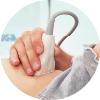
UC Davis patients avoided more than 5 million miles of travel and their associated environmental and financial costs by receiving clinical care via telehealth over the course of an 18-year period, UC Davis researchers reported online in the journal Value in Health. Researchers estimated patients saved nearly nine years of travel time and about $3 million by getting care at nearby telemedicine centers instead of at UC Davis in Sacramento. Emissions savings included nearly 2,000 metric tons of carbon dioxide, 50 metric tons of carbon monoxide, 3.7 metric tons of nitrogen oxides and 5.5 metric tons of volatile organic compounds.

Second cancers in children and adolescents and young adults are far deadlier than they are in older adults, and may partially account for the relatively poor outcomes of cancer patients ages 15–39 overall, according to a UC Davis study published in JAMA Oncology. The study also found that survival after almost all types of cancer is much higher when the cancer occurs as a primary malignancy than if it is a second cancer, and these survival differences are most pronounced in patients under age 40.

A UC Davis-led study published in The American Journal of Pathology found that mice fed a high-fat, high-sugar Western diet developed hepatic inflammation, which was more common in males than females and most pronounced in mice that lacked the bile acid receptor farnesoid x receptor or FXR. The study links diet to changes in the gut microbiota as well as bile acid profile, opening the possibility that probiotics and bile acid receptor agonists may be useful for prevention and treatment of hepatic inflammation and progression into advanced liver diseases.

Despite evidence that routine use of sonography in emergency departments can safely improve care for adults when evaluating for possible abdominal trauma injuries, UC Davis researchers could identify no significant improvements in care from sonography for pediatric trauma patients. The findings, from a randomized clinical study involving 925 children with blunt torso trauma evaluated in the emergency department, showed no difference in important clinical outcomes, authors reported in The Journal of the American Medical Association.

The survival rate of U.S. gunshot victims has not shown a marked improvement, as other recent studies have suggested, according to research from Duke University and UC Davis published in The American Journal of Public Health. While the purported increase in survival rate had been credited to improvements in emergency treatment and medical care, the Duke and UC Davis researchers found problems in the way data was collected and coded. Neither estimates of nonfatal shootings nor fatality rates changed much in the decade after 2003, they said.

Less is better when treating burn patients with blood transfusions, according to a multi-center study led by UC Davis researchers that found no difference in patient outcomes when the typical amount of blood transfused was reduced by half. The amount of blood to use in transfusion has been controversial because of risks such as infection, lung injury, fluid overload and clotting disorders, and the study is the first to define evidence-based best practices when using the procedure for burn patients.

